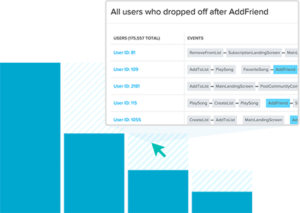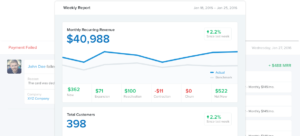We all know that Google Analytics is the dominant force in web analytics. It’s free, easy to setup an account, and records many of the metrics that digital marketers rely on out-of-the-box.
But Google Analytics has limitations.
Because of these limitations, new analytics platforms and solutions launch every day. The hardest part isn’t finding alternatives to Google Analytics – it’s finding time to vet and evaluate the ever-changing landscape of software.
Luckily, Conrad Wadowski of Teachable asked some of the top growth marketers which tools they felt were vital to their marketing stack. You can read all the specifics on his blog post, but suffice to say companies like HubSpot, Buffer, SumoMe, Growthhackers, and Segment participated, to name a few.
So which analytics tools do these high-growth companies use to improve their analytics? We’ve broken them out for you below.
Behavioral Analytics
One of Google Analytics’ biggest limitations is the lack of specific user data. This is a serious problem for companies looking to do advanced cohort or retention analysis. These products aim to fill that gap.
Like their website says, “Discover what your users are actually doing with behavioral analytics.” In real-life terms? Amplitude let’s you answer the tough questions about how certain user groups perform across devices, identify correlating factors to retention and churn, and make better product decisions. If you have an online portal, web app, or SaaS product, jump on their free starter plan and try it out.
Looking to measure user flow through your website funnels? How about trigger messages to users based on their behavior? While it was built with mobile apps in mind, MixPanel has a lot of practical applications for single-page websites, web apps & portals, and cross-device usage scenarios. And you can test it out for free!
[MixPanel] help[s] us quickly prove out hypotheses about customer engagement.
– Morgan Brown, COO at Inman
Heap is similar to some of the other behavioral analytics tools listed here, but it’s standout feature is retroactive analytics. Heap records everything from the day you install it, so if you don’t remember to set up an event for 3 months, you won’t lose out on that data. That’s huge.
User Experience
Raw metrics like Time on Page, Bounce Rate, and Pages per Session are fine for some companies but these often times don’t tell the complete picture. Modern marketers need more data about how users interact with content and UI elements. Enter these three analytics solutions.
SumoMe offers video recordings of user sessions, as well as heatmaps, which are a big step up from Google Analytics’ In-Page Analytics. Marketers will also appreciate the additional tools SumoMe provides, like content analytics, email collection lightboxes and tools to increase shares of your content.
UserTesting
This solution focuses on delivering real feedback on your website or mobile app. Feedback takes the form of audio commentary, written feedback, and videos of testers using your site. You can even sign up to do full panel tests with your own user base. No more wondering, “Do users understand this step?”
Want to watch customers as they navigate your drop-downs, click through forms, and use your checkout process? FullStory records site visitors so you can analyze their behaviors later and implement improvements. Get a bag of popcorn and watch 2 hours of users clicking things that aren’t buttons!
Feels like magic the first time you use it…Fantastic for tracking down hard-to-replicate UI bugs and for spying on user behaviors in the wild.
– Jamie Quint, Co-Founder at InterState Analytics
Landing Page Optimization
Despite efforts like Google Experiments, there really isn’t a great solution for split-testing and improving landing pages with Google Analytics. Luckily, marketers don’t have to look far for better conversion optimization tools.
While not limited to just landing pages, Optimizely’s A/B testing and optimization platform is nearly invaluable for improving your conversion rates. They’ve also rolled out additional personalization features in recent months that expands the tool’s usefulness.
An easy application to A/B test and personalize your website and mobile app.
– Amber Van Moessner, Director of Content at Livestream
A complete landing page management solution, Unbounce offers templates for building landing pages, or lets you build from scratch. Once pages are built, you can A/B test with real-time data to improve results.
Easy to design new tests quickly. This tool really helped us scale our digital demand gen by increasing conversion 10x.
– Nick Christman, VP of Performance Marketing at Namely
Other Great Tools
Several tools surfaced during Conrad’s study that deserved mentioning, because of their importance in specific situations, to certain industries, or because they allow for scaling up analytics efforts. Here they are, in no particular order.
Multi-touch attribution reporting is somewhat of a unicorn for marketers working on multi-channel campaigns. Did that lead from retargeting originally come from Twitter? Is AdWords driving all those conversions by itself, or is it getting assistance from our paid content promotion? InterState aims to solve that.
Fantastic tool for attribution reporting, enables B2B-specific attribution models.
– Guillaume Cabane, VP of Growth at Segment
If you’re in SaaS or any other subscription-based recurring revenue, you need to look at Baremetrics. Metrics like Revenue per User, Monthly Recurring Revenue, User Churn, Upgrades/Downgrades and more make this tool vitally important from an analytics and business growth standpoint.
The challenge with having multiple analytics solutions is that you have to do collection and manage a number of different scripts, ensure that they are all placed correctly and pulling the right data, and it’s very time-consuming. Enter Segment, which tracks data across website and apps, then normalizes it and sends it to various systems like the ones mentioned previously in this article.
The Six Million Dollar Man Analytics
If you’ve been getting by with just Google Analytics up until now, it’s time to rebuild your analytics stack like Steve Austin – better, stronger, faster than before!
Analytics isn’t “one size fits all” – it’s critical to build a set of systems that fit your company’s unique needs. The tools on this list have been vetted and vouched for by some top companies, and they’ll give you a great start towards taking your analytics to the next level.
And of course, if you’d like a partner who has walked this path many times before, our team is happy to help you assess and implement any analytics solutions you need.



